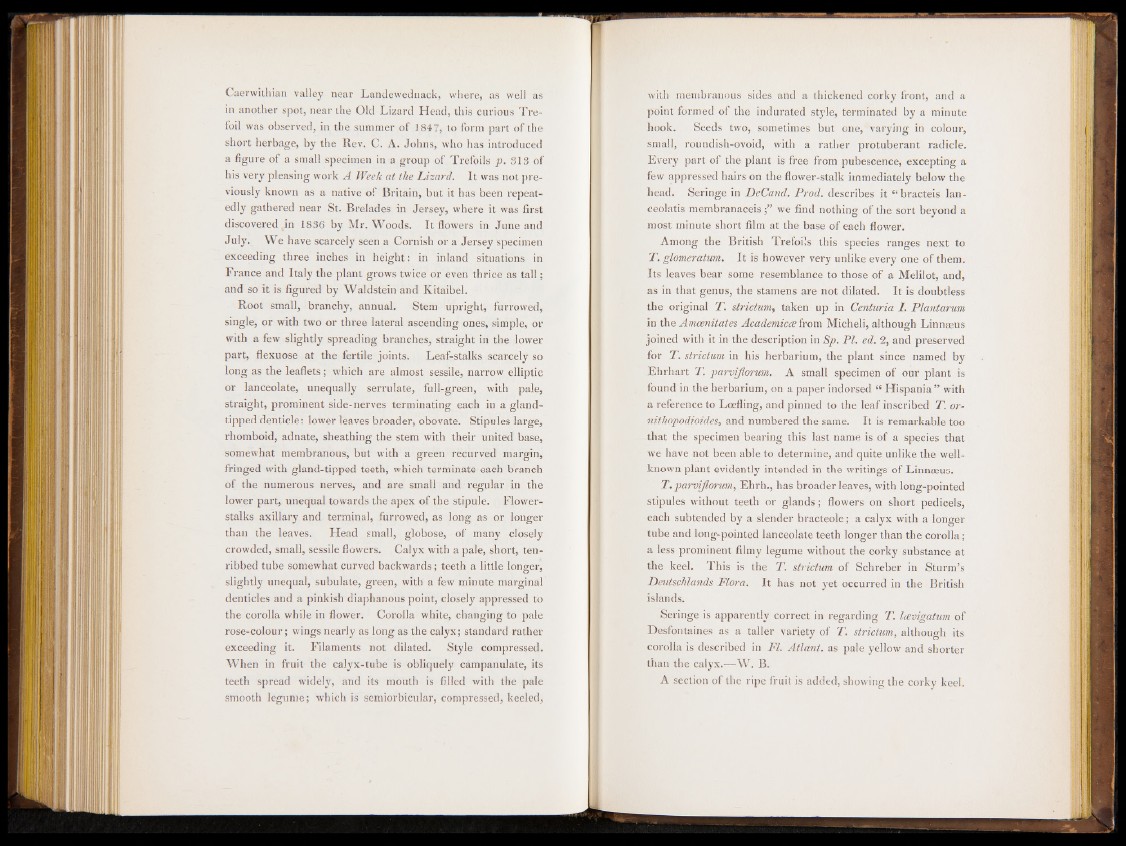
Caerwithian valley near Landewednack, where, as well as
in another spot, near the Old Lizard Head, this curious Trefoil
was observed, in the summer of 1847, to form part of the
short herbage, by the Rev. C. A. Johns, who has introduced
a figure of a small specimen in a group of Trefoils p. 313 of
his very pleasing work A Week at the Lizard. It was not previously
known as a native of Britain, but it has been repeatedly
gathered near St. Brelades in Jersey, where it was first
discovered in 1836 by Mr. Woods. It flowers in June and
July. W e have scarcely seen a Cornish or a Jersey specimen
exceeding three inches in height: in inland situations in
France and Italy the plant grows twice or even thrice as tall;
and so it is figured by Waldstein and Kitaibel.
Root small, branchy, annual. Stem upright, furrowed,
single, or with two or three lateral ascending ones, simple, or
with a few slightly spreading branches, straight in the lower
part, flexuose at the fertile joints. Leaf-stalks scarcely so
long as the leaflets; which are almost sessile, narrow elliptic
or lanceolate, unequally serrulate, full-green, with pale,
straight, prominent side-nerves terminating each in a gland-
tipped denticle: lower leaves broader, obovate. Stipules large,
rhomboid, adnate, sheathing the stem with their united base,
somewhat membranous, but with a green recurved margin,
fringed with gland-tipped teeth, which terminate each branch
of the numerous nerves, and are small and regular in the
lower part, unequal towards the apex of the stipule. Flower-
stalks axillary and terminal, furrowed, as long as or longer
than the leaves. Head small, globose, of many closely
crowded, small, sessile flowers. Calyx with a pale, short, ten-
ribbed tube somewhat curved backwards; teeth a little longer,
slightly unequal, subulate, green, with a few minute marginal
denticles and a pinkish diaphanous point, closely appressed to
the corolla while in flower. Corolla white, changing to pale
rose-colour; wings nearly as long as the calyx; standard rather
exceeding it. Filaments not dilated. Style compressed.
When in fruit the calyx-tube is obliquely campanulate, its
teeth spread widely, and its mouth is filled with the pale
smooth legume; which is semiorbicular, compressed, keeled,
with membranous sides and a thickened corky front, and a
point formed of the indurated style, terminated by a minute
hook. Seeds two, sometimes but one, varying in colour,
small, roundish-ovoid, with a rather protuberant radicle.
Every part of the plant is free from pubescence, excepting a
few appressed hairs on the flower-stalk immediately below the
head. Seringe in DeCand. Prod, describes it “ bracteis lan-
ceolatis membranaceis ;” we find nothing of the sort beyond a
most minute short film at the base of each flower.
Among the British Trefoils this species ranges next to
T. glomeratum. It is however very unlike every one of them.
Its leaves bear some resemblance to those of a Melilot, and,
as in that genus, the stamens are not dilated. It is doubtless
the original T. strictum, taken up in Centuria I. Plantarum
in the Amcenitates Academicce from Micheli, although Linnaeus
joined with it in the description in Sp. PI. ed. 2, and preserved
for T. strictum in his herbarium, the plant since named by
Ehrhart T. parviflorum. A small specimen of our plant is
found in the herbarium, on a paper indorsed “ Hispania” with
a reference to Lcefling, and pinned to the leaf inscribed T. or-
nithopodioides, and numbered the same. It is remarkable too
that the specimen bearing this last name is of a species that
we have not been able to determine, and quite unlike the well-
known plant evidently intended in the writings of Linnaeus.
Tparviflorum, Ehrh., has broader leaves, with long-pointed
stipules without teeth or glands; flowers on short pedicels,
each subtended by a slender bracteole; a calyx with a longer
tube and long-pointed lanceolate teeth longer than the corolla;
a less prominent filmy legume without the corky substance at
the keel. This is the T. strictum of Schreber in Sturm’s
Deutschlands Flora. It has not yet occurred in the British
islands.
Seringe is apparently correct in regarding T. Icevigatum of
Desfontaines as a taller variety of T. strictum, although its
corolla is described in FI. Atlant. as pale yellow and shorter
than the calyx.—W. B.
A section of the ripe fruit is added, showing the corky keel.